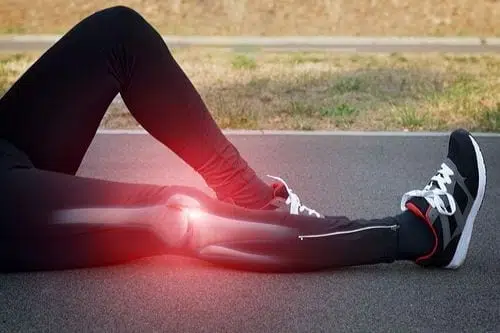
This post discusses problems and Social Security . If your is preventing you from working, read on for how SSA will evaluate your claim for .
The Bishop Law Firm represents Social Security Disability clients in North Carolina and we do not get paid unless we win. We offer free case reviews by phone or you can start your free case review online now.
Types of Problems
can arise from , overuse, or . Common injuries are sprains, bursitis, meniscus tears, dislocations and fractures.
Most minor injuries (strains and sprains) heal on their own while others require Via MedicineNet.com). If you injured your while working, you may also have an claim (NC Workers' Compensation).
If you knees were injured in a recent car accident, you may also have a personal injury claim (NC Car Accident Injury).
(Avascular Necrosis) has similar to but it causes bone disease and eventual collapse. In my clients with Avascular Necrosis their progress from no to excruciating and back to no when the bone itself has died.
(mechanical wear and tear) occurs when the cushioning between joints () wears away. With the loss of eventually bones will rub resulting in chronic joint , swelling, stiffness and decreased range of motion. can be caused by age, heredity or gender. Via WebMed .
I frequently meet clients who have sustained injuries to their knees in their youth who have now developed with age.
can also be caused by (). Rheumatoid arthritis is an autoimmune disorder that can cause in the knees and in all joints of your body. RA is usually treated with immunosuppressants that have their own side affects.
issues are diagnosed by x-ray or MRI. Treatment for issues includes weight loss, medications, , injections (steroid or hyaluronic), braces and finally . can range from arthroscopic, to .
is usually not recommended for younger adults because of the chance it will have to be repeated later in life. In turn, can be difficult to recover from for older adults.
Types of
There are two main types of SSA that you may be eligible for: Social Security Insurance (SSDI) and Supplemental Security Income (SSI).
Social Security Insurance is based on the credits from the work you have done in your life, while SSI is a need based program. You must be found disabled before you are entitled to either benefit.
At every step of the Disability Process, SSA uses the Five Step Sequential Evaluation to determine if you are disabled.
- Step 1 – Are You Working? The Social Security Administration defines work as “Substantial Gainful Activity” (SGA). SGA is roughly defined as work from earnings that average more than $1,470 (2023) a month. If you are making that amount you generally will not qualify for disability.
- Step 2 – Is Your Condition “Severe”? Severity is key when it comes to what qualifies as a disability. Severe is defined by the Social Security Administration as: your condition must interfere with basic work-related activities for your claim to be considered.
- Step 3 – Is Your Condition on the List of Disabling Conditions? The Listings are very hard to meet in most cases and not always interpreted as a common reading would suggest. If you meet a listing you are gravely ill. The listings are found here.
- Step 4 – Can You Do the Work You Did Previously? The Social Security Administration will look at your past work and determine if it was sedentary, light, medium, or heavy. They also will evaluate the skill level: unskilled, semi-skilled and skilled. For instance, an attorney would be sedentary skilled work. The Dictionary of Occupational Titles is found here.
- Step 5 – Can You Do Any Other Type of Work? If the Social Security Administration finds that you cannot do what you used to do, they then look to see if you can do anything else. This is where the “grids” come into play. The grids are the Medical-Vocational Guidelines. The grids are only for exertional impairments. Non-exertional impairments are not considered by the grids. If you are found to be capable of any other work, you will be found not disabled. Read The Grids and Your Social Security Disability Case.
[embedyt] https://www.youtube.com/watch?v=uMOzS3QO4_E[/embedyt]
Can you get disability?
In order to qualify for disability with "bad knees", you will need a medical diagnosis and medical records demonstrating how your knee issues affect your ability to work.
Severity is the ultimate issue with problems and Social Security . If your knee issues are causing chronic joint pain, you have imaging demonstrating the cause of your knee pain (MRI, x-ray..), and your knee pain continues to affect your ability to walk despite following medical advice, you may be approved for disability.
In addition, your issues must last or be expected to last for a continuous period of not less than 12 months. Many people have treatment and are able to return to work in less than a year, but some do not.
The SSA will evaluate your claim for based on problems under listing 1.00 Musculoskeletal Disorders or under the Grid Rules.
As with most of SSA's listings, the musculoskeletal listings are difficult to meet. Specifically, Listing 1.18 (Abnormality of a major joint in any extremity) requires all of the below:
- Chronic joint pain or stiffness AND
- Abnormal motion, instability or immobility of the affected joint AND
- Anatomical abnormality of the affected joint as noted on physical examination or by imaging AND
- Medical documentation of at least one of the below:
- Need for walker, bilateral canes or bilateral crutches or a wheeled and seated mobility device involving the use of both hands
The Grid Rules offer help for those who are over the age of 50, have a certain level of education and few work skills who are limited to sedentary work from their knee issues.
If you have been unable to work for a year or if you foresee that you will be unable to work for a year due to your problems, apply for as soon as possible. While treatment may be successful, it may take substantial time for you to heal.
The Bishop Law Firm represents Social Security Disability clients in Raleigh, Durham, Fayetteville, Cary, Rocky Mount, Wilson, Smithfield, Louisburg, Chapel Hill, Roanoke Rapids and surrounding areas in North Carolina. Call us today for a free case review, (919) 615-3095 or start online now.

